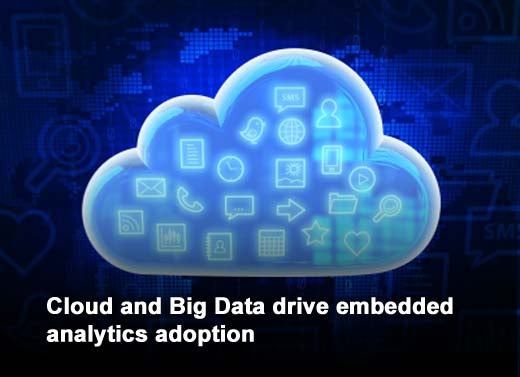For what seems like decades now, business intelligence (BI) has been proclaimed as the “next big technology” for enterprises. However, due to a variety of factors that include the high degree of specialization needed to use many BI tools and the cost of these solutions, it has yet to reach the high adoption levels that many have long expected.
Things may finally be starting to change, though. Karl Van den Bergh, vice president of Product and Alliances for Jaspersoft, joins us to look at the current state of BI, how embedded analytics are driving a renaissance for the industry and to provide a few real-world examples of embedded analytics in action.
Click through for a look at the current state of BI, how embedded analytics are driving a renaissance for the industry and a few real-world examples of embedded analytics in action, as identified by Karl Van den Bergh, vice president of Product and Alliances for Jaspersoft.
There is a growing recognition that businesses today essentially compete on time and information. It is this realization that is driving the investment in reporting and analytics. Yet, in spite of the massive spend on analytics — $34 billion in 2012 according to IDC — and that business intelligence continues to be at the top of CIOs’ list of priorities, business intelligence is still only used by about 25 percent of information workers.
The reason for this low penetration of business intelligence (BI) is that most business users don’t spend their working day inside a BI application, nor do they want to. They already have their preferred applications like a customer relationship management (CRM) system or an enterprise resource planning (ERP) tool. In order to make BI pervasive, vendors are beginning to bring analytic intelligence to users inside of their preferred apps instead of as a separate, standalone tool. This enables users to find the right report or dashboard relevant to their question.
It is for this reason that leading industry analysts are recognizing that embedded BI represents the next major wave in BI. As analyst Wayne Eckerson comments, “In many ways embedded BI represents the fulfillment of BI’s promise, in which it becomes an information service that informs day-to-day operations and automatically triggers decisions and actions that drive the business.”
Thanks to the rise of the new IT stack, powered by cloud platforms and Big Data stores, it is becoming much easier and more cost effective to embed analytics. Cloud platforms remove the complexity of deploying a BI system and emerging utility-based pricing models make it much more cost effective to embed. New Big Data stores also make it much easier and more affordable to analyze significantly larger volumes of data than would have been previously possible.
There are many examples of embedded analytics in business. One such example is Red Hat’s Enterprise Virtualization (RHEV) platform. RHEV includes dashboards and analytics to provide IT administrators with the ability to monitor and optimize their virtualized infrastructure based on historical and real-time data.
Larger organizations will often build their own custom applications. One example is the United States Navy, which built an application for its Naval Safety Center to provide analytics that help the Navy monitor and track safety incidents, and allowing them to modify policies that lead to an improved safety record.
Virgin runs a multi-tenant Web property through its Virgin Money Giving division focused on non-profits. The website embeds dashboards and the ability to generate custom reports and analyses, allowing charitable organizations to track and optimize their campaigns and fundraising efforts.
JAGEX Game Studios operates massively multiplayer online role-playing games (MMPORPG) including RuneScape, the world’s largest free-to-play MMPORPG. These games embed intelligence that allows players to track and improve in-game progress through interactive dashboards.
Whether they’re in your favorite game, your preferred business application or your bank’s website, embedded analytics are becoming increasingly common. As evidence of this, Gartner estimates that by 2015, 25 percent of analytics capabilities will be embedded, compared to only 5 percent in 2010. And the business benefits are evident. According to an Aberdeen study, 89 percent of embedded analytics users saw substantial improvement in collaboration and knowledge sharing. It seems clear that embedded analytics are indeed the next big thing in BI.












